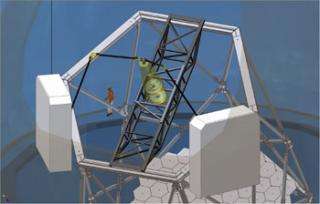University of Texas at Austin to study elusive dark energy

Light might soon be shed on one of the great enigmas of the universe -- dark energy --thanks to a $5 million challenge grant from Harold C. Simmons of Dallas to The University of Texas at Austin.
Simmons’ grant will help fund the Hobby-Eberly Telescope Dark Energy Experiment (HETDEX) at the university’s McDonald Observatory by matching the next $5 million in private support received.
Discovered in the late 1990s, dark energy is a force causing the universe to expand at an accelerating rate. But scientists are unable to say what the energy is or how it fits with the known laws of physics.
“We know that it dominates the universe,” said David Lambert, a University of Texas at Austin astronomer and the director of McDonald Observatory. “In fact, it composes an estimated 73 percent of the universe, while so-called dark matter accounts for 23 percent, and matter of the familiar kind—the stars, galaxies, all known life—composes only 4 percent.”
Simmons, the chairman of Contran Corp., holds bachelor’s and master’s degrees in economics from The University of Texas at Austin. He has previously given to the school’s athletic programs and its McCombs School of Business, as well as to the University of Texas Southwestern Medical Center at Dallas.
He said he hopes this gift will help HETDEX make astronomical history.
“I find the question of dark energy intriguing and I am glad to help support the innovative research program at McDonald Observatory,” Simmons said.
HETDEX is the best contender for solving the riddle of dark energy, Lambert said, because it will combine a large telescope, a large amount of observing time and an innovative instrument that will allow for a three-dimensional map of up to one million galaxies.
“Many in the scientific community believe that understanding the nature of dark energy is the No. 1 question in all of science,” he said. “We cannot observe dark energy in the laboratory because its effects are seen only on enormous scales. So the universe has to be the laboratory.”
“Harold Simmons’ grant is a terrific example of how philanthropists and universities can be partners in the quest for new knowledge,” said UT President William Powers Jr. “I share Harold’s enthusiasm in this project. The university is extremely grateful for his generosity.”
A team of three UT astronomers—senior research scientists Gary Hill and Phillip MacQueen and Associate Professor Karl Gebhardt—is developing HETDEX using the Hobby-Eberly Telescope, which is the third largest in the world. With support from Simmons and other donors, the McDonald Observatory is upgrading the telescope’s field of view from four arc minutes to 20 arc minutes.
Source: University of Texas at Austin





















